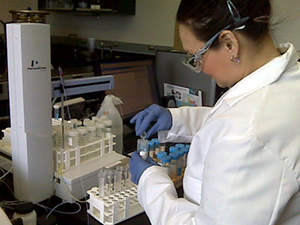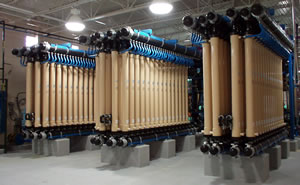Click here for information about Arsenic in Spanish.
- Compliance with Arsenic Maximum Contaminant Level
- Arsenic Compliance
- USEPA Arsenic Health Effects Language
- Arsenic Removal Demonstration Plant
Compliance with Arsenic Maximum Contaminant Level

A Water Authority Water Quality Laboratory Analyst prepares a sample to be analyzed for arsenic using Inductively Coupled Plasma-Mass Spectrometry (ICP-MS).
The Water Authority maintains compliance with the 10 Parts Per Billion (PPB) MCL for arsenic by:
- Selectively pumping wells.
- Using pipelines and pump stations to move low-arsenic well water to other parts of the system.
- Treating higher-arsenic well water at the Arsenic Removal Demonstration Plant and two other plants on the West Side.
- Distributing very low-arsenic drinking water from the San Juan-Chama Drinking Water Project.
Arsenic compliance monitoring results for the most recent NMED monitoring in 2023-2025 by Distribution Zone are shown on the map.
Arsenic Compliance
When rocks, minerals, and soil erode, they release naturally occurring arsenic into ground water. Arsenic occurs in varying amounts in ground water in Albuquerque. San Juan-Chama surface water has very low levels of arsenic.
USEPA defines where and how often compliance samples must be collected for analysis. For arsenic, samples must be collected at each Entry Point to the Distribution System (EPTDS) once every three years.
Current results for arsenic are shown in the map on the Water Quality by Distribution Zone webpage. Although all of the results met the 10 PPB standard, some of the water contained arsenic concentrations between 5 PPB and 10 PPB. Consumers need to be aware of USEPA’s health effects language for arsenic.
USEPA Arsenic Health Effects Language Applies As Follows:
For water containing greater than 5 PPB of arsenic and up to and including 10 PPB of arsenic: While your drinking water meets USEPA’s standard for arsenic, it does contain low levels of arsenic. USEPA’s standard balances the current understanding of arsenic’s possible health effects against the costs of removing arsenic from drinking water. USEPA continues to research the health effects of low levels of arsenic, which is a metal known to cause cancer in humans at high concentrations and is linked to other health effects such as skin damage and circulatory problems.

Microfiltration Units at the Arsenic Removal Demonstration Plant
Arsenic Removal Demonstration Plant
The plant was completed and in operation in July 2007. The plant removes arsenic from water pumped from three West Side wells. The plant is used in combination with the San Juan-Chama Drinking Water Project distribution pipelines to carry the low arsenic water to other storage tanks across the West Side. The plant, which can treat 5.2 million gallons per day, is the largest facility of its kind in the world. The $6.3 million plant was built with financial assistance from the Federal government.


